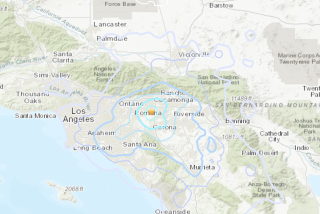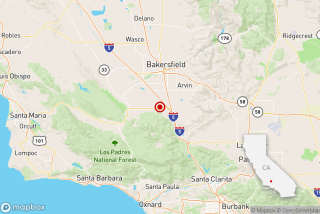Freaky ‘frost quakes’ boom and shake frozen Midwest towns
- Share via
Bizarre cold-weather phenomena called frost quakes — which generate shaking and ear-splitting sounds likened to exploding bombs — have blasted towns across the Northeast and upper Midwest during this extraordinarily frigid winter.
Thanks to social media reports, researchers have been able to study frost quake reports submitted from Minnesota, Indiana, Illinois, Missouri and Canada and talk to those who felt and heard the unsettling booms and shakes.
“Experiencing them is not only incredibly unnerving, but due to snow cover it’s unknown if these loud, house-shaking booms have done any unseen damage,” said Ashley King, of Toronto, who believe she first felt one on Jan. 6.
King lives on the top floor of a 15-story Toronto building and likened the sound to two bowling balls being knocked together.
“People here are used to hearing regular cracks and pops in the winter as the cold weather causes pipes and structures to expand and contract,” she said. “These frost quakes sound much louder and deeper.”
Another apparent frost quake awoke her around 5 a.m. the next day, she said.
“I went on Twitter and found several tweets from people who were awoken by the same thing, at the same time, around the same area as my apartment building,” she said.
Frost quakes have a scientific name: cryoseism. The term also includes the cracking and slipping of glacial ice and the fracturing of frozen lake ice, said Clifford Thurber, a geophysics professor at the University of Wisconsin Madison.
He guesses that the frozen water tables are tens of meters long. The most intense frost quake he’s seen was a magnitude 1.5.
“Even though their source sizes are small, the shaking they cause at the surface can be large because they occur so close to the surface,” Thurber said in an email to the Los Angeles Times. “But typically they will not be felt very far away.”
And social media have given researchers a new way to study the little-discussed temblors.
“Since frost quakes are rare, localized, cannot be monitored and tend to cause only minimal damage, the scientific community has very limited amount of information,” said University of Toronto Scarborough Climate Laboratory researcher Andrew Leung.
They might crack roadways and building foundations, but that kind of result is rare.
Frost quakes can strike after a pounding of rain or when the rapid melting of snow saturates underground streams. When temperatures suddenly reach near 0 degrees, the water table expands and starts cracking the soil and smashing nearby rock formations. Witnesses have described the sounds as being similar to gunshots, exploding bombs and falling trees.
Since the beginning of the year, Leung has tracked numerous frost quakes in freeze-gripped parts of the Midwest.
While visiting Texas during Christmas, King heard news reports of “booms” in her hometown and turned to Twitter to see what people were saying. She assembled a Google Map to allow users to pinpoint and describe their own frost quake experience.
“It amazed me how gracious people were to have a Web page where they could see that other people were hearing and feeling the same strange events as them,” King said.
“Soon enough, it appeared to everyone that these noises were not random due to the sheer volume of reports,” Leung said.
King’s map shows frost quake markers in states such as Maine, New York, Ohio, and Wisconsin. As recently as Sunday, 911 operators in Illinois and Missouri took reports from callers who said they heard booms.
Leung suggested that in addition to social media reports, frost quakes have garnered extra attention becuase they have occurred in a major city, Toronto. It’s more typical to hear of booms once every few years in rural areas of states such as Wisconsin and Massachusetts.
ALSO:
Judge in ‘affluenza’ case rules out jail time for teen driver
One suspect had Philip Seymour Hoffman’s cell number, officials say
Winds of change: Floating power turbines envisioned off Oregon coast
More to Read
Sign up for Essential California
The most important California stories and recommendations in your inbox every morning.
You may occasionally receive promotional content from the Los Angeles Times.











